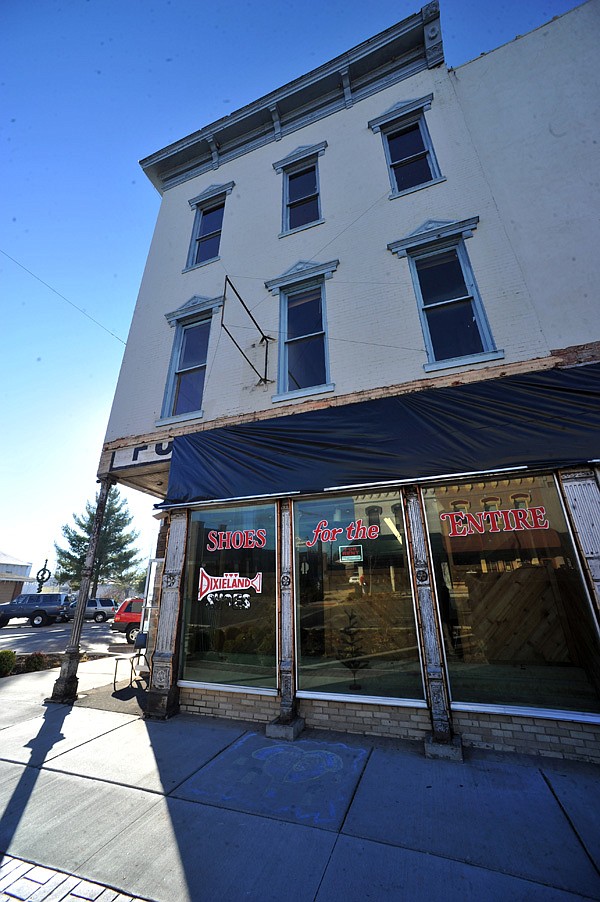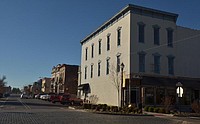Architect Plans Restoration of Rogers Opera House
The old Dixieland Shoes store on the corner of Walnut and First streets in Rogers is being renovated by new owner John Mack of JKJ Architects. He is restoring the building, which includes the Opera House on the second floor, once a grand theater. To see a photo gallery go to nwaonline.com.
Thursday, November 22, 2012
Opera Houses Popular in Early 20th Century
Staff Report
Rogers wasn’t the only city in Northwest Arkansas with an Opera House.
The Fayetteville Opera House was built in 1905 north of the historic courthouse by the Knights of Pythias for $25,000. Visitors were offered a variety of entertainment from Shakespeare to oration from William Jennings Bryan, and music from the Saint Louis Symphony Orchestra.
In later years, vaudeville acts, minstrel shows and motion pictures were featured. Two years after it was built, the building was referred to locally as the Ozark Theater, a tribute to the Ozark Club, a group of prominent socialites who met in the theater’s lounges and gaming rooms.
Over the years, the roof over the main auditorium collapsed and was condemned by the city, which led to renovation of the building. The auditorium and stage were removed from the back of the building, but the front portion, used for offices, was retained. The team renovating the building decided that it would be too expensive to return the front facade to its original look. An exterior finish was added as were faux columns to make the front look similar to the original design.
The building at 2 N. College Ave. now houses Mitchell Communications.
Not much is known about the Springdale Opera House. Historians say the building was constructed in 1894. It was destroyed in a fire and never rebuilt.
The center of Rogers’ social life in the late 19th and early 20th centuries is set for restoration after years of neglect. John Mack, owner of JKJ Architect, recently purchased the building housing the Opera House at 106 and 108 W. Walnut St. The Opera House is on the second level of the building.
“It going to be a big job and will likely take a while to restore, but I’m excited about the prospects,” Mack said.
The two and three-story building, once renovated, will house retail on the ground level, with the Opera House and office space on the second story. A third story was added on the corner section of the building in 1903.
“I’m not exactly sure what the third story will be. We are just starting on the renovation project. We might consider living or office space. I’ll make a decision on that later,” Mack said.
No one is sure the exact date the building was built, said Gaye Bland, director of the Rogers Historical Museum.
“We know it was before 1890, because we have information on some of the shows, lectures and meetings that took place in 1890. I would say the Opera House was the John Q. Hammons Center of its day,” Bland said.
“We know in 1903 there was lecture on Russia and the Mozart Symphony Orchestra and the Chicago Glee Club performed in the Opera House,” Bland said.
The lower section at the corner of First and Walnut streets housed Hunt’s Department Store and American National Bank at different times. Most recently it was home to Dixieland Shoes.
“When moving pictures came along in the 1920s, the Opera House began to decline as the entertainment, meeting and lecture center for the community,” Bland said.
In 1930, a boxing ring was installed in the Opera House to attract an audience. By mid-1935, the Opera House was no longer in use, Bland said.
“I’m very excited about the restoration of the Opera House,” Bland said. “For John, this is a labor of love restoring a historical building and giving it a modern day function.”
The Opera House is approximately 6,000 square feet in size and seated 630 people. Mack said he will reduce seating to between 295 and 315.
“The balcony is actually bigger than the lower level of the opera house. It holds more people than the lower level. The seats were pretty good where ever you sat,” he said.
A wall off-stage is still covered with signatures of performers who once played the house.
Rogers High School staged its senior plays at the Opera House for many years. Several student signatures are on the wall from 1910 to 1920.
“We are going to research the names to see if there are relatives of those performers still around we could talk with and maybe add to the history of the building,” Mack said.
Part of the ground floor of the building is already listed on the National Register of Historic Buildings.
“We tried once to get the Opera House listed, but there had been too many changes to the original building so it didn’t qualify. We hope to restore it to the point we can get it listed as a historical site,” Mack said.
Mack said the restoration project will be difficult.
“There is no air conditioning or heating upstairs. As modern technology came along, the plumbing, electricity, heating and air conditioning lines were just nailed to the wall or run on the floor of the Opera House to the ground floor,” Mack said. “All of that will have to be redone and the roof has some leaks after a fire destroyed building the next to Opera House. In 1974, a load bearing column was removed and that has to be fixed,” Mack said.
Mack has bought and restored other downtown structures. His architect firm is located in a renovated second floor office at 116B W. Walnut St.
Photo Gallery
Opera House restoration
The former Opera House, the center of Rogers social life in the late 19th and early 20th century is set for restoration after years of neglect. John Mack, owner of JKJ Architects, recently purchased the building at 106 and 108 W. Walnut St. and has high hopes for the opera house. Photos by Michael Woods
“I have a strong attachment to downtown Rogers and the historic building. Sometimes I look at the this project and think it could be an albatross around my neck. Then I think how much fun I’m going to have restoring the Opera House and the rest of the building,” Mack said.
Downtown merchants toured the Opera House on Wednesday.
“John has taken on quite an undertaking,” said Clarice Moore, owner of The Rabbit’s Lair. “He has the knowledge and the passion for restoration. I think it’s going to be great for downtown.”
“You really need to look at the view out the third story windows. It’s fantastic,” said Chelsey Baker with UB Bank.
Mack said the Opera House will be more than just a historic site.
“I think there is a need for small historic venue for meetings, art and other events that can serve the community,” Mack said.

